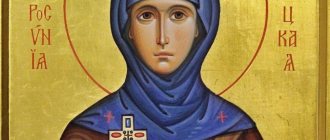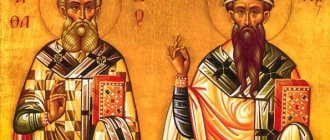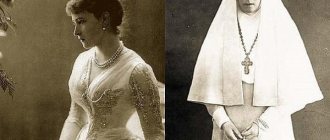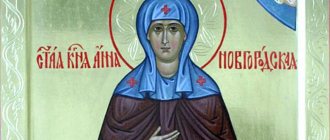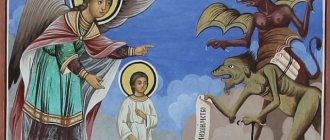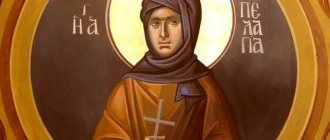Euphrosyne of Polotsk. Fresco on the northwestern pillar of the Transfiguration (Spasskaya) Church of the Polotsk Euphrosyne Monastery On June 5 (May 23, old style), the church honors the memory of St. Euphrosyne of Polotsk as the patroness of Russian nuns. She is the first famous Russian abbess and the first known mentor of all Russian women who have chosen the path of spiritual improvement and asceticism. She is also called the “mother of the Russian land” and the mother of female monasticism in Rus'.
Life of Venerable Euphrosyne of Polotsk
The history of Russian female monasticism itself has many blank spots. For example, the first chronicle news of the founding of a convent dates back to 1089. At the same time, it is obvious that women's holy monasteries existed in Kyiv already in the first half of the 11th century: we find some information about this in the life of St. Theodosius of Pechersk, which talks about the tonsure of his mother in the monastery at the Church of St. St. Nicholas, built by Princess Olga on the grave of Askold (northwest of Berestov at the confluence of the Chertyrya River and the Dnieper). Among the founders of Russian female monasticism, the most famous are the venerable ascetics of the 12th-13th centuries - Euphrosyne of Polotsk and Euphrosyne of Suzdal, whose biographies have survived to this day. The name "Euphrosinia" translated into Russian means "joy".
The exact date of birth of the Monk Euphrosyne is unknown: according to various sources, the interval between 1100 and 1104 is indicated. She came from a noble family of the Holy Equal-to-the-Apostles Prince Vladimir and was the eldest daughter of the Polotsk Prince Svyatoslav-George, the youngest son of the Polotsk sovereign Prince Vseslav Bryachislavich. Her parents called her Predislava: at that time there was still a custom to give newborns Old Church Slavonic names before baptism. As a princess, she was taught to read books and from a young age she loved learning so much that she surprised her parents. Hearing about the beauty, intelligence and piety of the Polotsk princess, many neighboring princes wanted to have her as their bride, but, as the life of the saint tells, the young girl, who at the age of twelve already had a perfect mind, thought within herself as follows:
“What will happen now that my father is thinking of hiding me as a husband? If this happens, then there is no way to drive away the sorrows of this world. Packs in his speech: “Why did our former ancestors succeed before us?” And married, encroached and princely, but not forever yours; their life passes by and their glory perishes like dust and worse than a spider. And those of the former wife, having taken the strength of a man, followed in the footsteps of Christ, their groom, giving up their bodies to the wounds, and their heads to the sword, and others, even though they did not bow their necks to iron, but cut off carnal pleasures from themselves with a spiritual sword, giving up their bodies to fasting and vigil and kneeling and lying on the ground, then these are memorials on earth, and their names are written in heaven, and there the angels glorify God without ceasing. And this glory is dust and ashes, and like smoke disperses, and like vapor of water perishes.”
But her parents still intended to get Euphrosyne married, and then she decided to secretly leave her father’s house and entered the monastery, where her aunt, Abbess Romania (the widow of Prince Roman Vseslavich), was the abbess. The abbess, fearing her father's wrath, initially tried to convince the young ascetic to return home, but she remained adamant, and then Romania blessed her for tonsure. For some time, the newly tonsured Euphrosyne stayed in the monastery, then, with the blessing of Bishop Elijah of Polotsk, she went into seclusion and settled in the “cabbage roll” - a special cell at the St. Sophia Cathedral in the city of Polotsk.
Having strengthened herself in spiritual exploits, the saint received a revelation from above to leave solitude and go to struggle for the salvation of her neighbors. So, the angel of the Lord appeared to her three times, pointing to the place for the future women's monastery, which she was to found. With the same instruction, an angel appeared to Bishop Elijah of Polotsk. Fulfilling the will of God, Bishop Elijah gathered the princes and boyars and, telling them about the vision, said: “Behold, in your presence I bless Euphrosyne a place at the Church of the Holy Savior on Seltse, so that there will be a nunnery there. Let no one hinder or take away from her what I have given her.”
In Selets, Euphrosyne founded two monasteries - a female and a male one, which became the center of education in the Principality of Polotsk. Almost nothing is known about the male Bogoroditsky monastery, but the Spaso-Euphrosinievsky Orthodox convent, founded in the 12th century, still stands and operates on the ancient land of Polotsk. By order of Euphrosyne for a convent in 1161, goldsmith Lazar Bogsha created a cross-ark to store Christian relics sent from Constantinople and Jerusalem (this cross was known as the cross of Euphrosyne of Polotsk, but in 1941 the ancient cross was lost, and in 1997 an exact copy was made). For the monastery, through the diligence of the saint, an ancient icon of “Our Lady Hodegetria of Ephesus” was acquired from Byzantium, according to legend, painted by the Evangelist Luke himself (or, as modern researchers claim, one of its oldest copies).
Cross-ark. Made by goldsmith Lazar Bogsha, 1161.
In her newly created maiden monastery, the Venerable Euphrosyne herself became the first abbess, and her sister Gradislava, with the name Evdokia, and her cousin Zvenislava, monastically Eupraxia, were tonsured there. When she entered the monastery, Zvenislava donated to the monastery all her precious clothes and utensils that were prepared for her marriage.
Reverend Euphrosyne of Polotsk is called the first female librarian in Rus'. She spent her free time from prayer copying manuscripts. It should be noted here that this kind of work was considered a purely male occupation and required considerable physical effort. The scribe wrote not on the table, but on the palm of his left hand, with which he rested his elbow on his knee. They wrote on parchment in a pattern - large and straight, without slanting, each letter was separated from the next one. To do this, it was necessary not only to know grammar perfectly, but also to have certain artistic abilities: the initial letters and section headings should be decorated with intricate animal or floral patterns, in addition, books were often decorated with specially written capital letters, drop caps or initials and miniatures. Thus, no more than four pages could be copied per day.
Some of the books copied by Euphrosyne were sold to rich churches and monasteries, and the proceeds were distributed to the needy. For poor churches, the monk copied holy books for free. Scriptoria were organized at the monasteries - workshops for copying books, in which there was a specialization: one master made colored initials and titles, the second - miniatures, the third - bindings; there were also schools for teaching literacy and icon-painting workshops. In the monasteries founded by Euphrosyne, beautiful monuments of book art were created, for example, the Pogodin Gospel of the 11th century.
At the end of her life, Euphrosyne, with the blessing of Bishop Dionysius, together with her brother David and cousin Eupraxia, went on a distant pilgrimage: first to Constantinople, then to the Holy Land. Around 1173 (or 1167) she reached Jerusalem and venerated the Holy Sepulcher. Comforted after this by the angelic notification of the eternal rest prepared for her, St. Euphrosyne, calling the presbyter, received the Holy Mysteries of Christ and, after a twenty-four-day serious illness, gave up her spirit into the hands of God on the 23rd day of May 1173 (according to other sources - 1167). Her body was buried in the monastery of Saint Theodosius, near Jerusalem, at the porch of the Church of the Most Holy Theotokos, where the mothers of Saints Sava and Theodosius and many other holy wives were once buried.
Prayers
Troparion, tone 4
Imitating the twelve-year-old Christ, / who taught the word of God in the sanctuary, / you followed, Euphrosyne. / Leaving the temporal glory and the earthly betrothed, / and despising all the worldly, / you disgraced the most beautiful Christ of all, / taking up the cross, walking the path of the angelic life / and Instructing many to Him, / in the fragrance of peace, you ascended into the Heavenly Palace, / where you prayed, You loved Him, / for those who reverently honor your memory.
Troparion, tone 4
Having squandered your wealth on the beggars/ and counted your princely glory for nothing,/ you, the red maiden, abhorred the temporary betrothed/ and, disgraced by the Bridegroom Christ,/ to him, like a vein, you brought purity of soul and body, Euphrosyne./ To him now he is in joy. as you stand, / remember us who honor your memory.
Kontakion, tone 8
Chosen by God from birth/ and recognized to serve Him,/ in the rank of angels of the Lord, who served holyly,/ and lived reverently,/ and now, with the Heavenly powers, praising the Lord,/ for us, sinners, interceding before the Lord,/ with joy and love Let us cry:/ Rejoice, Euphrosyne, all-honorable bride of Christ.
Kontakion, tone 8
Our pure virginity and honor/ with alms, like a lamp with oil, who adorned/ and with the wise virgins entered into the bright chamber of Christ,/ let us please the glorious Euphrosyne/ and, falling to the honest with her power, we will enjoy her fragrance/ and cry out to her tenderly:/ as having boldness towards Christ God / pray to be delivered from the stench of passions and to save our souls.
Veneration and glorification of the Venerable Euphrosyne of Polotsk
Church veneration of St. Euphrosyne in the Polotsk land began at the end of the 12th century. Already at this time, there was a church service for the saint and a hagiographic “Life” (probably created in one of the monasteries founded by Euphrosyne). The life of the Venerable Euphrosyne of Polotsk is one of the oldest and most widespread: more than a hundred lists of “life” are known. In the 16th century, the life of the Venerable Euphrosyne of Polotsk was included by Saint Macarius in the Great Chetya Menaion, and then in the “Book of Degrees”. After this, two prologue editions of the life were made, and in the 18th century, St. Demetrius of Rostov included the life of the saint in his “Books of the Lives of Saints.” According to tradition, St. Euphrosyne is also recognized as a saint by the Catholic and Uniate churches.
Without the name of Euphrosyne of Polotsk it is impossible to imagine the spiritual life and culture of Belarus. The Transfiguration Cathedral, erected by her diligence, has been preserved to this day in its original form, and serves as a monument of extreme antiquity and architecture of the 12th century. Today, this is the only temple in Belarus where there are paintings from those times. The Monk Euphrosyne also had a significant influence on political and social life in Polotsk in the middle of the 12th century. It was a kind of banner of the Polotsk residents’ struggle for their independence. Euphrosyne always tried to improve relations between the warring appanage princes and actively acted as a peacemaker. At the Rurik settlement in Novgorod, a seal of Euphrosyne was found, which confirmed the great role of the princess-abbess in the political life of the Russian lands in the middle of the 12th century.
Seal of Euphrosyne of Polotsk
"Life" says that Euphrosyne did not want to see anyone as enemies: "Neither prince with prince, nor boyars with boyars, nor servant with servant - but she wanted to have everyone, as if she had one soul."
Interesting Facts
The description of the life of Mother Superior Euphrosyne contains a number of interesting facts. These include the following:
- Princess Euphrosyne received her education at a young age directly at the princely court. Only clergy were hired as teachers for girls. Instead of standard textbooks, they used Holy Scripture and hagiographic literature.
- In Euphrosyne’s house there was a large library, where the girl studied not only religious literature, but also novels, collections of sayings and aphorisms of famous people. Later, she became interested in reading works that described the essence of nature.
- After being tonsured as a nun, the Venerable Euphrosyne not only occupied herself with copying the sacred books, but also wrote her own. In them she included prayers, teachings and a number of translations from Greek and Latin. The princess also corresponded with like-minded people to exchange knowledge.
- The Cross of Polotsk Euphrosyne is considered a rare and unusual work of art, which the most famous collectors strive to acquire. The location of the cross remains unknown, and it is considered a priceless item and one of the shrines of Belarus.
- At the monasteries opened by Euphrosyne there were workshops where many of her students worked. Many items made by students have survived into modern times, including medallions, jewelry, and canvases.
Relics of St. Euphrosyne of Polotsk
After the capture of Jerusalem by Muslims, in 1187 the coffin with the relics of the saint was transferred and buried in the Feodosiya Cave of the Kiev Pechersk Lavra. In 1910, by personal decree of Emperor Nicholas II, her incorrupt remains returned to their homeland and were placed in the Spaso-Evfrosinevsky Monastery in a specially made cypress shrine, lined with silver. Believers donated 12 thousand rubles for cancer.
Transfer of the relics of St. Euphrosyne of Polotsk. Photo from 1910
The cancer of Euphrosyne of Polotsk disappeared in the 20s of the 20th century. During the evacuation in World War I in 1915, St. the relics were transferred to the Rostov Abrahamic Monastery.
In February 1919, the People's Commissariat of Justice of the USSR adopted a resolution according to which an organized opening of holy relics was carried out throughout the country. There, in Rostov, in 1920, the tomb was opened, and on May 13, 1922, already in Polotsk, it was opened again, the relics were sent to an atheistic exhibition in Moscow, and from there to the exposition of the Vitebsk Local History Museum. All church valuables, including a 40-pound silver shrine, were confiscated. Now the incorruptible relics of St. Euphrosyne rests in the Church of the Exaltation of the Cross in Polotsk Spaso-Euphrosyne Convent.
Tomb with the relics of St. Euphrosyne in the Far Caves of the Kiev Pechersk Lavra
Famous princess
Euphrosyne of Polotsk... This name is inscribed in golden letters not only on the pages of the spiritual life that existed in the East Slavic lands, but also in the entire history of the culture of Belarus.
Euphrosyne of Polotsk - princess and nun. But, above all, she is a famous educator who left an unforgettable memory in the souls of people. Between the present time and the period when the famous princess lived, there are more than eight centuries. And therefore, it is not surprising that not much information about it has been preserved in the history of the East Slavic people. However, they are also able to evaluate the great Polotsk woman as a talented female educator, pointing out her pan-European significance. All the activities of Euphrosyne, as well as her famous compatriots K. Smolyatich and K. Turovsky, without any doubt, speak of the high cultural upsurge that was observed in those years on Belarusian soil.
Venerable Euphrosyne of Polotsk. Icons
The iconography of Euphrosyne developed mainly in modern times in Russia, Ukraine and Belarus. In the texts of icon painting originals of the 18th century. on May 23, the appearance of the saint is likened to that of the Saint. Evdokia. The fresco on the northwestern pillar of the Transfiguration (Spasskaya) Church of the Polotsk St. Euphrosyne Monastery, discovered in 1950 by D. E. Bryagin, was considered the oldest image of Euphrosyne for a long time. The earliest surviving images of the saint in icon painting also include a small (86×33 cm) life-size Deesis icon, located in the top row of the iconostasis in the chapel in the name of the monastery. Sophia of the Smolensk Cathedral of the Novodevichy Convent. The icon was painted in 1685 under the direction of F. E. Zubov (GIM). The saint is represented in prayer, in a robe and in a doll, half-turned to the right (“at the right hand” of Jesus Christ), next to the Holy Spirit. Evdokia. In the same row are images of other reverend wives.
Venerable Euphrosyne of Polotsk. State Historical Museum, Moscow. 1685
In the 1st third of the 19th century. a large canvas was created with the figure of Euphrosyne (located in the warm church in the name of Euphrosyne of the Spassky Monastery in Polotsk), standing in a cell half-turned to the right near a table with a cross, books and rosary, in the left hand - a cross made by the jeweler Lazar Bogsha (1161), the right - the palm points to the princely regalia (ermine robe, scepter and crown; this gesture is found mainly in images of the Grand Duke Alexander Nevsky). The saint's gaze turned upward is a characteristic feature of works of academic painting, dating back to the art of the 18th century. Euphrosyne is dressed in a monastic robe with a pectoral cross; the background is dark with a slight highlight near the head. In the Kiev Pechersk Lavra, where the relics of Euphrosyne resided until 1910, there are several images of her. The image of Euphrosyne was invariably introduced into the composition “The Cathedral of the Kiev-Pechersk Saints,” which from the 2nd half. XVIII century became widespread in icon painting, graphics, and decorative and applied arts.
Venerable Euphrosyne of Polotsk. Modern icon
Venerable Euphrosyne of Polotsk. Modern icon
Choosing a life path
The Polotsk princess was distinguished not only for her wisdom, but also for her beauty. However, she rejected the numerous marriage proposals she received without any hesitation. Predslava consciously decided to abandon worldly life at the age of 12. This was the period when parents first began to think about their daughter’s marriage. The girl was guided by ideas about ascetic service to high moral ideals and the importance of spiritual improvement. The princess decided to follow her “Groom” - Christ.
Predslava turned to a relative who lived in Polotsk, the widow of her uncle Roman Vseslavich. She was an abbess and could help the girl become a nun. However, the extraordinary beauty of Predslava and her early age seemed to the old princess incompatible with tonsure. The girl’s deep intelligence and high religious conviction helped to convince the old princess. The abbess called a priest, who tonsured him, giving Predslav the name Euphrosyne.
Venerable Euphrosyne of Polotsk. Temples
The Orthodox Women's Monastery of the Savior Euphrosyne can be called the main attraction of Polotsk, as well as the center of Belarusian Orthodoxy and spirituality, which annually attracts thousands of pilgrims. Like Polotsk itself, the ancient holy monastery has experienced many troubles and hardships over the years of its existence. In the XVI-XVIII centuries. Depending on the political situation, the monastery passed from Orthodox to Catholic several times, but in the 19th century it finally returned to the Orthodox. In the 20s of the 20th century, the monastery was closed and the valuables were requisitioned. Since 1990, the monastery has been revived again as a functioning Orthodox convent.
Women's Orthodox Spaso-Euphrosinievsky Monastery in Polotsk (ROC)
Pre-schism churches in honor of Euphrosyne of Polotsk have not survived, and in the Old Believers there are no churches in the name of St. Euphrosyne.
What do they ask for before the image?
By praying before the image of the abbess, believers ask for salvation, deliverance from addictions, protection of loved ones, and a peaceful existence. The text of the church prayer contains an appeal and praise to the holy princess Euphrosyne. Before the image they read not only a prayer, but also a kontakion and a troparion.
The image of St. Euphrosyne of Polotsk in art
The image of Euphrosyne was embodied by Olga Ipatova in the story “Predislava”; she also appears in the novels “Saints and Sinners” by Alexander Osipenko and “The Called” by Valentina Kovtun.
In the city of Pruzhany (Belarus), a street was named in honor of Euphrosyne of Polotsk.
Many Belarusian poets dedicated their poems to the Belarusian enlightener: Vladimir Orlov (“Euphrosyne”), Oleg Bembel (“The Region of Euphrosyne”), Grigory Borodulin (“In the Polotsk Church of the Savior Euphrosyne”), Danuta Bichel-Zagnetova (“Euphrosyne of Polotsk”), Naum Galperovich (“I’ll freeze my eyelashes, and the evening will float”), Larisa Geniush (“Euphrosyne of Polotsk”, “I’ll go to the mountains under your wounds”), Sergey Zakonnikov (“The Light of Euphrosyne”), Alexander Zvonak (“The Shadow of Euphrosyne”), Vasily Zuenok (“The Last Prayer of Euphrosyne of Polotsk”, “Looking for God”), Oleg Loiko (“Euphrosyne of Polotsk”), Valentin Luksha (“Frescoes of Saint Euphrosyne”), Alexander Ryazanov (“Warning”), Lyudmila Rublevskaya (“Euphrosyne”), Victor Shnip (“Christ’s Bride”), Sergei Poniznik (“Confession”), Leonid Dranko-Maisyuk (“Euphrosyne”).
Victor Vasnetsov. Venerable Euphrosyne of Polotsk
The famous Polotsk woman is reflected on the canvases of Nelly Schastnaya, Alexey Marochkin, Alexey Kuzmich, on the graphic sheets of Arlen Kashkurevich, on the tapestry of Simon Svistunov.
Opening your own monastery
According to the “Life…”, Elijah, Bishop of Polotsk, received confirmation from God’s angel of the height of Euphrosyne’s asceticism and service. At the same time, higher powers pointed out to him that he should place a nun at the head of the monastery. Three times with similar news an angel appeared to St. Euphrosyne, who joyfully accepted Christ’s choice. Seltso, located not far from Polotsk, was chosen for the location of the monastery. The Church of the Savior was located here and the burial place of bishops was located.
The ceremonial transfer of Selts to Euphrosyne took place in the St. Sophia Cathedral. Bishop Ilya himself blessed the Venerable One to create a nunnery in this place.
Construction of the Spassky Cathedral
As historical documents testify, the birth of the monastery was marked by a significant event - the beginning of the construction of the Spassky Cathedral, which was also initiated by the nun Euphrosyne. The work on the construction of the main volume of the building was completed in a record time for those times - 30 weeks, that is, one construction season.
Of course, such an important matter could not have happened without the help of the Higher Powers. “The Life” tells, in particular, that one day, when the builders ran out of their main plinth material - thin square-shaped baked brick, through the prayers of Euphrosyne, the missing quantity miraculously appeared before them.
The construction in Seltse was led by the outstanding architect of the pre-Mongol period, John. The Church of the Holy Savior, erected by him and surviving to this day, is the only building on the territory of the Republic of Belarus where frescoes from the 12th century have been preserved in their original form.
Relative of the Byzantine emperors
The exact date of her birth is controversial among researchers, but, according to the most authoritative experts, it falls in 1104. It is known that in holy baptism the future saint received the name Predslava. Subsequently, upon entering monasticism, she changed it to Euphrosyne, under which she entered Russian history.
In 1068, the princess’s grandfather, Prince Vseslav Bryachislavich, who won the Kiev throne with a sword, placed his sons on appanage reigns, but since Euphrosyne’s father, Svyatoslav Vseslavich, was the youngest of them, he took control of his native Polotsk, which was a large commercial and administrative center. not received. There is an opinion of a number of scientists that for his reign he was given Vitebsk, which was less significant at that time. In it, as is commonly believed, the Venerable Euphrosyne of Polotsk was born.
The name of the mother of the future saint also causes discussion in the scientific world. The eldest daughter of Vladimir Monomakh, Sofia, is considered the most likely. If this opinion is correct, then Euphrosyne of Polotsk herself is a relative of the Byzantine emperor Manuel I Komnenos. However, many dispute this point of view. Predslava (Euphrosinia) was the eldest, but not the only child in the family. The Tale of Bygone Years, as well as the Life, compiled after her death, mention younger brothers and sisters.
What else is known
It is impossible to describe all the interesting moments from the life of such a multifaceted personality. Let's list some:
- The saint is considered the patroness and intercessor of Belarus.
- She loved and composed music herself.
- She patronized artists and is considered the first philanthropist in Belarus.
- She took part in the political life of the state.
- In politics I tried to play the role of a peacemaker.
- Euphrosyne is recognized as a saint not only by Orthodox Christians, but also by Catholics.
- In 2007, a commemorative silver coin was issued in Belarus.
- Temples in honor of the saint are located not only in Belarus and Russia, but also in America and Canada.
Parents
There is no exact information about Euphrosyne’s parents and the date of her birth. Belarusian researchers consider 1104 to be the most likely year of her birth.
The saint’s father was George , one of the younger sons of the Polotsk prince Vseslav Bryachislavovich, who is mentioned in “The Tale of Igor’s Campaign . However, George is the name given at baptism. It could have belonged to one of the prince’s two sons - Svyatoslav or Rostislav, whose fates were very similar.
Even less is known about the mother. It is believed that her name was Sofia and she came from an ancient princely family. Predslava had brothers, sisters, numerous nephews and nieces.
The parents were against their daughter going to the monastery. But she did not change her decision, which she made at the age of 12. The name for the tonsure was chosen in honor of Euphrosyne of Alexandria, with whom the girl wanted to follow an example in everything.
Secret tonsure of the prince's daughter
It is known that, having received a good education at home and early mastery of literacy, Predslava from a young age became addicted to reading religious literature - the only books available at that time. This largely determined her future fate. When, upon reaching adulthood, that is, twelve years of age, the father tried to marry the girl off, finding her a dynastically suitable groom, she categorically refused. Moreover, breaking ties with secular life, Predslava secretly took monastic vows as a nun, taking the name Euphrosyne.
The abbess of the Polotsk convent, where the tonsure took place, was Euphrosyne’s own aunt, the widow of Prince Roman Vseslavich. At first, she resisted her niece’s decision in every possible way, fearing her father’s anger, and tried to turn her away from her decision. Only after much persuasion did the abbess bless the girl to take such a decisive step.
Her fears, as it turned out, were not in vain. “Life” tells that Svyatoslav Vseslavich was “plunged into sadness” by this news, and the whole family grieved with him about what happened. However, judging that “everything is God’s Will,” he resigned himself and made no attempts to return the fugitive.
Love of books
Euphrosyne (then Predslava) received a good education, knew foreign languages, and loved to read since childhood. When she became a nun, she settled in a cell near the St. Sophia Cathedral, where she began copying books.
Copying books at that time was hard work, which only men . Titles in books had to be decorated with artistic designs. I could write no more than 4 pages per day. “The hand on the book turns dull white,” wrote the Polotsk poet Naum Galperovich.
Shrine created in the workshop of the Spassky Monastery
An important stage in the educational activities of Abbess Euphrosia was the creation of jewelry and icon painting workshops in the premises of the monastery she headed. In 1161, one of the most skilled craftsmen of that time, Lazar Bogshe, made at her order a pectoral cross with a reliquary built into it - an ark, where the incorruptible relics of the holy saints were kept. For many centuries it was a shrine of the Belarusian people, and at the same time a monument to their ancient writing.
Kept for many years in the Spassky Monastery, this cross was taken to Smolensk in the 13th century, and then in 1514, by order of Ivan III, it was sent to Moscow. His grandson, Ivan the Terrible, returned the relic to its homeland. During the Napoleonic invasion, in order to save the cross from enemies, it was walled up in a niche in the wall of the St. Sophia Cathedral, and after the expulsion of the French, it was again placed in the Spassky Monastery.
Having survived centuries and the troubles that befell Russia, the priceless relic was irretrievably lost during the Soviet years. Even during the nationalization of church values, it was disfigured by breaking off precious stones and stripping off the gilding. When Soviet troops retreated from Mogilev in 1941, the 12th-century cross was abandoned to the mercy of fate, after which it disappeared without a trace. The article presents a photo of its copy made in our time.
